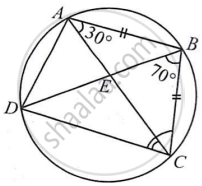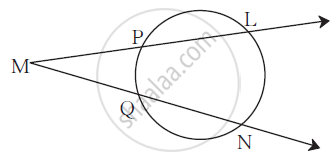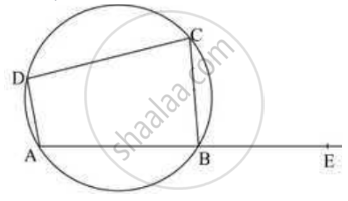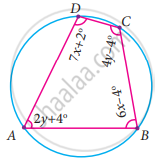Advertisements
Advertisements
Question
ABCD is a cyclic quadrilateral whose diagonals intersect at a point E. If ∠DBC = 70°, ∠BAC is 30°, find ∠BCD. Further, if AB = BC, find ∠ECD.
Solution

For chord CD,
∠CBD = ∠CAD ...(Angles in the same segment)
∠CAD = 70°
∠BAD = ∠BAC + ∠CAD = 30° + 70° = 100°
∠BCD + ∠BAD = 180° ...(Opposite angles of a cyclic quadrilateral)
∠BCD + 100° = 180°
∠BCD = 80°
In ΔABC,
AB = BC ...(Given)
∴ ∠BCA = ∠CAB ...(Angles opposite to equal sides of a triangle)
⇒ ∠BCA = 30°
We have, ∠BCD = 80°
⇒ ∠BCA + ∠ACD = 80°
30° + ∠ACD = 80°
⇒ ∠ACD = 50°
⇒ ∠ECD = 50°
APPEARS IN
RELATED QUESTIONS
Prove that "Opposite angles of a cyclic quadrilateral are supplementary".
If the non-parallel sides of a trapezium are equal, prove that it is cyclic.
Prove that the line of centres of two intersecting circles subtends equal angles at the two points of intersection.
Two chords AB and CD of lengths 5 cm 11cm respectively of a circle are parallel to each other and are on opposite sides of its centre. If the distance between AB and CD is 6 cm, find the radius of the circle.

In the figure m(arc LN) = 110°,
m(arc PQ) = 50° then complete the following activity to find ∠LMN.
∠ LMN = `1/2` [m(arc LN) - _______]
∴ ∠ LMN = `1/2` [_________ - 50°]
∴ ∠ LMN = `1/2` × _________
∴ ∠ LMN = __________
In the given figure, ABCD is a quadrilateral inscribed in a circle with centre O. CD is produced to E such that ∠AED = 95° and ∠OBA = 30°. Find ∠OAC.

ABCD is a cyclic quadrilateral. M (arc ABC) = 230°. Find ∠ABC, ∠CDA, and ∠CBE.

Find all the angles of the given cyclic quadrilateral ABCD in the figure.
In a cyclic quadrilaterals ABCD, ∠A = 4x, ∠C = 2x the value of x is
If bisectors of opposite angles of a cyclic quadrilateral ABCD intersect the circle, circumscribing it at the points P and Q, prove that PQ is a diameter of the circle.
